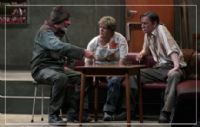Review: The Man Who Fell To Pieces
Date: 27/02/2018
Theatre Review

A mini-masterpiece detailing an examination of mental health within and without one man's struggle with depression, Patrick J O'Reilly's frank, funny and poignant The Man Who Fell To Pieces, produced by Tinderbox Theatre for the Edgefest Festival at Belfast's MAC, surpasses itself by translating an off-the-wall concept into seventy-five minutes of explosive, gritty theatre through passionate and innovative staging, scoring, scripting and acting.
Were you to contemplate The Man Who Fell To Pieces at face value, you may find it rather incredulous, ridiculous even. Its central premise of a man literally falling to pieces, which are put in a bag and carried around by his girlfriend, sounds like something out of Monty Python. But put it in this context, with these actors, and you get several remarkable close encounters of the musical, verbal, mental and physical kind. This is actually a most personal story for O'Reilly, his real-life struggles with depression re-invented and depicted in an unforgettably piercing and lively manner.
The Man Who Fell To Pieces contains one of the most unusual and ingenious opening sequences to grace any stage. Actors Shaun Blaney, Maria Connolly, Roisin Gallagher and Patrick Buchanan hold up a series of placards, pictures and frames to introduce the play and their respective characters – the titular man, John, his mother Alice, John's girlfriend Caroline and the handyman Henry. All of this is soundtracked by one of many eighties-inspired compositions from Katie Richardson, her soothing, enriching mixture of haunting and harmonious synth and vocals perfectly attuning itself to the play.
Switching between the p-o-v of John, as a detached narrator, and everyone else, as no longer detached participants in the (after?) life of a man now literally in pieces, O'Reilly draws upon multiple perspectives, aided by the numerous moods in Richardson's score and Ciaran Bagnall's detailed set, to create several viewpoints for the audience to take in.
John's multi-coloured "pieces", brought to Connolly's Alice by Gallagher's Caroline, are as much a prop as they are a character. They are used to depict his well-being, or lack of it, at work and at home while Alice hires Henry to "put John back together" with staples, sticky tape, cement and so on. Naturally he cannot.
This is funny, but also revelatory, in that while Alice's love for her son is not in question ("I'm a good mum!", she proclaims), the manner of it is: if John seems to exist in a vacuum while he narrates about himself, so do Alice, and Caroline, and even Henry, as they go about their business.
That is the price of fragile, superficial insulation, where lack of unified understanding can be a destructive force in family and romantic relationships. The cracks in the floor of the house, the rust on the kitchen sink and the lumps in the milk that has gone off are all further condemnations of a promising unit that has let itself fall to pieces, largely because the right kind of communication is missing.
And poor communication is fatally rampant in a home where dependence is common. As confident as Caroline seems on the surface, she is driven into states of insecurity and hysteria following the break-up with and break up of John, her pleasures amounting to carrying him around, and miming their dances together.
And while Alice's longing for John to be "repaired" allows her to literally repair herself - as her multi-coloured patchwork dress (created by Connolly!) shows - her newfound charge ultimately gives the wrong impression to Henry, causing unwelcome havoc.
Perhaps the solution, at least for Alice and Caroline, could have been, and may still be, to sit down, listen and think more than talk. And to try and grasp something warming and a warning: as humans, we are not, or at the very least should not be, alone.
Simon Fallaha
The Man Who Fell To Pieces ran at The MAC, Belfast, from February 6-11 as part of the Edgefest Festival. For more information go to tinderbox.org.uk.
Were you to contemplate The Man Who Fell To Pieces at face value, you may find it rather incredulous, ridiculous even. Its central premise of a man literally falling to pieces, which are put in a bag and carried around by his girlfriend, sounds like something out of Monty Python. But put it in this context, with these actors, and you get several remarkable close encounters of the musical, verbal, mental and physical kind. This is actually a most personal story for O'Reilly, his real-life struggles with depression re-invented and depicted in an unforgettably piercing and lively manner.
The Man Who Fell To Pieces contains one of the most unusual and ingenious opening sequences to grace any stage. Actors Shaun Blaney, Maria Connolly, Roisin Gallagher and Patrick Buchanan hold up a series of placards, pictures and frames to introduce the play and their respective characters – the titular man, John, his mother Alice, John's girlfriend Caroline and the handyman Henry. All of this is soundtracked by one of many eighties-inspired compositions from Katie Richardson, her soothing, enriching mixture of haunting and harmonious synth and vocals perfectly attuning itself to the play.
Switching between the p-o-v of John, as a detached narrator, and everyone else, as no longer detached participants in the (after?) life of a man now literally in pieces, O'Reilly draws upon multiple perspectives, aided by the numerous moods in Richardson's score and Ciaran Bagnall's detailed set, to create several viewpoints for the audience to take in.
John's multi-coloured "pieces", brought to Connolly's Alice by Gallagher's Caroline, are as much a prop as they are a character. They are used to depict his well-being, or lack of it, at work and at home while Alice hires Henry to "put John back together" with staples, sticky tape, cement and so on. Naturally he cannot.
This is funny, but also revelatory, in that while Alice's love for her son is not in question ("I'm a good mum!", she proclaims), the manner of it is: if John seems to exist in a vacuum while he narrates about himself, so do Alice, and Caroline, and even Henry, as they go about their business.
That is the price of fragile, superficial insulation, where lack of unified understanding can be a destructive force in family and romantic relationships. The cracks in the floor of the house, the rust on the kitchen sink and the lumps in the milk that has gone off are all further condemnations of a promising unit that has let itself fall to pieces, largely because the right kind of communication is missing.
And poor communication is fatally rampant in a home where dependence is common. As confident as Caroline seems on the surface, she is driven into states of insecurity and hysteria following the break-up with and break up of John, her pleasures amounting to carrying him around, and miming their dances together.
And while Alice's longing for John to be "repaired" allows her to literally repair herself - as her multi-coloured patchwork dress (created by Connolly!) shows - her newfound charge ultimately gives the wrong impression to Henry, causing unwelcome havoc.
Perhaps the solution, at least for Alice and Caroline, could have been, and may still be, to sit down, listen and think more than talk. And to try and grasp something warming and a warning: as humans, we are not, or at the very least should not be, alone.
Simon Fallaha
The Man Who Fell To Pieces ran at The MAC, Belfast, from February 6-11 as part of the Edgefest Festival. For more information go to tinderbox.org.uk.




































